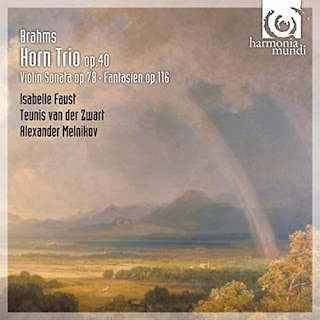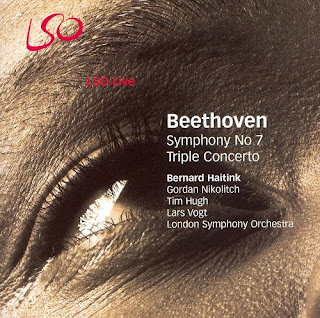Most of you will have come across the 'ten albums' thing on Facebook that has been circulating since lockdown began. The premise is that people post ten albums that have great meaning to them on Facebook without explanation whilst tagging friends to take part at the same time. Having now been tagged three times I feel I can't avoid the exercise any longer.
I've been thinking about this quite a bit and have decided to post the ten albums here with explanation. I know this is against the rules, sorry, but if you can drive from London to Durham in lockdown and all that...
Anyway, I wanted to include explanation as these ten albums are a fond look back at the beginning of my love affair with classical music, around the age of 18. Sure, I'd played classical instruments since childhood but I'd not really appreciated or loved the music properly until then. My story goes like this...
Film music is a way into classical music for many people and it was no different for me. It helped that I was a total Star Wars geek in my teens. The music from the films couldn't fail to make an impact on me and I had to have it to listen to in my shiny new personal CD player. Here also began my love affair with the London Symphony Orchestra. The LSO of the seventies was by then a thrillingly virtuosic orchestra and perfect for symphonic film scores like this.
But it wasn't until I woke up to the final movement from this symphony on Classic FM one morning as I was struggling with a major relationship breakup, that my classical music journey really took off:
Apologies for the poor photo quality. I discovered this CD in HMV after hearing that amazing music on the radio. Here began my love affair with the music of Sergei Prokofiev. He remains my favourite composer to this day. I'm fascinated by his personality as well as his musical genius and those two things are inextricably linked. This is clear when you read his diaries. For me, his music is open-hearted and direct, which is perhaps why it resonates with me so much. I can't possibly document his whole output and life story here but in his later music composed in the Soviet Union it is quite obvious to me when he is being sarcastic and when he is being genuine. I don't imagine many of the Soviet officials could tell the difference, such was his genius.
Russian music has long been a staple of mine. Prokofiev's music offers a glimpse both forward into modernism and backwards into Russian nationalism. It was easy to move into the music of Stravinsky and Shostakovich from there as well as Rimsky Korsakov and the world of the 'Mighty Five' nationalist composers.

Musorgsky (oh how we love all the different spellings of Russian names) didn't write a huge amount of music. He was obviously a troubled guy. What he did write depicts, for me, a raw picture of the Russian soul (inasmuch as a random English guy like me imagines). I'm not a massive opera fan but Boris Godunov and Khovanschina contain some of my favourite music and harmonic progressions. Claudio Abbado's Musorgsky albums are so important as he really is the advocate for the composer on disc. The LSO once again is on terrific form in the above album, particularly in the fantastic original version of St John Night on a Bald Mountain (or whatever it gets called variously). You won't want the Rimsky version ever again once you hear that. No other conductor gets close.
For someone who has conducted more Beethoven than anything else, it may come as a surprise to know that I avoided his music like the plague until about 2003. I was young and naive and basically couldn't see the attraction to such 'tonic dominant' music without colour and interesting orchestration (see above). I was a postgraduate student in Manchester at this time. Then I heard Beethoven on period instruments. That changed everything. Those colours I couldn’t hear before? Right there all of a sudden. It was mostly bands like the Orchestra of the Age of Enlightenment I was hearing at that time on radio broadcasts but I soon moved on to the new wave of Beethoven recordings from chamber orchestras with a period feel.

This set in particular spent a long time in my car CD player but looking back now it’s a pity Harnoncourt didn’t go for antiphonal violins as that spoils things for me a bit now. Curiously, these kinds of recordings and performances helped me eventually appreciate the kind of ‘big band’ Beethoven performance style that I’d been repelled by for so many years previously. I can take Beethoven most ways now (though I’d say chamber orchestras remain my preferred purveyors).

The period instrument movement and chamber orchestra treatment of Beethoven led me to similar approaches to Mozart, Haydn, Schubert and Schumann, which deepened my connection with these composers. This was all around the time I was training to be a conductor and forming my own chamber orchestra. These styles have heavily influenced my approaches when conducting these composers but I have to say recordings like the above are my guilty pleasures and I’ve increasingly swung back to broader tempi in more recent years. I have to say I’m not the greatest Barenboim fan but it is time to talk about a recording from my conducting hero who just might have had a massive influence on me.
Sir Colin really is one of my great conducting heroes and a man I was lucky enough to meet and observe in rehearsal as well as concert. As with Prokofiev, I am fascinated with his personality - something of a sharp-edged and fiery fellow in his younger days but who made the transition to a calm, wise and kindly master who was most understated about his own position in the music-making. His style is unmistakeable, however. He gave
space to the music: space for it to breathe, space between phrases, space for an upbeat. He had a fantastic and unmistakable baton technique, wielding the stick like a sabre, yet with the utmost clarity.
This brings me to Elgar, not a composer I had any affinity for prior to hearing this recording. It was the way I came to know Elgar symphonies and so I was quite shocked to realise subsequently that most recordings of these works do
not sound like this! Many of his ‘Indian summer’ recordings like this on LSO Live are revelatory in their own way. The sound is, of course, far from ideal in the Barbican acoustic but once your ear adjusts it’s fine. While we’re talking about late Romantic...
Here’s how I got into Mahler. This composer once seemed impenetrable to my younger self. I guess at the time Sir Simon moved to Berlin I had only recently got into attending classical concerts and so I sadly missed most of his Birmingham tenure. His somewhat god-like status around here led me to check out this recording (as well as the concert video relay). It’s Rattle at his best, finding all those fantastic crunch points in the music and playing them for all they are worth. I don’t rate his recordings generally but his Mahler is always worth a listen. It’s not my library choice now (that remains Chailly with the Concertgebouw), partly because the horns are woefully under-balanced, but I do like to go back to it every now and then. If you like it then go on to Abbado and then Chailly.
It wouldn’t be right to talk about my love affair with classical music and not mention Brahms, who remains my second favourite composer. He is still a composer who divides opinion even amongst people with a great appreciation of classical music. I can see why - it’s not music that’s easy to ‘get’ unless you’ve either played it or really found that magical recording that converts you. Two discs are particularly special for me:
Be warned, this is music that is likely to ‘get you’ if you’re feeling in any way sensitive or emotional. More than that, though, it’s the sound of the natural horn (preferred by the composer over the more modern valved instrument) that works so well that makes this first choice for me. Then there’s these:

That Gewandhausorchester sound! Rich, dark, fiery. These are epic performances by a fine and un-showy pianist. I’ve a lot of time for Chailly, too. He really transformed the orchestra into what it is today - and brought back antiphonal violins!
What to choose for my final album? I considered going for something I have been listening a lot to recently. I guess I actually have so many different recordings of the works I love that it makes it hard to narrow them down. Having cycled through many beloved composers in my head I have alighted on...Mozart.
This set was a revelation. The sound - a modern instrument chamber orchestra with natural horns, trumpets and timpani - is just spot-on for this repertoire. I don’t know any other recordings that come close to this though many have merits of course. If I could bottle this style and hear Haydn, Mozart, Schumann, Beethoven and Schubert in it I certainly would. This orchestra has, of course, recorded these other composers but none have the impact nor freshness of Mackerras here.
So, that’s my album thing. Just a snapshot of the hundreds of recordings I’ve listened to over the years. Maybe the list would look different on a different day but it’s nice to get chance to look back at my journey into classical music, which thankfully never gets tiring.
















